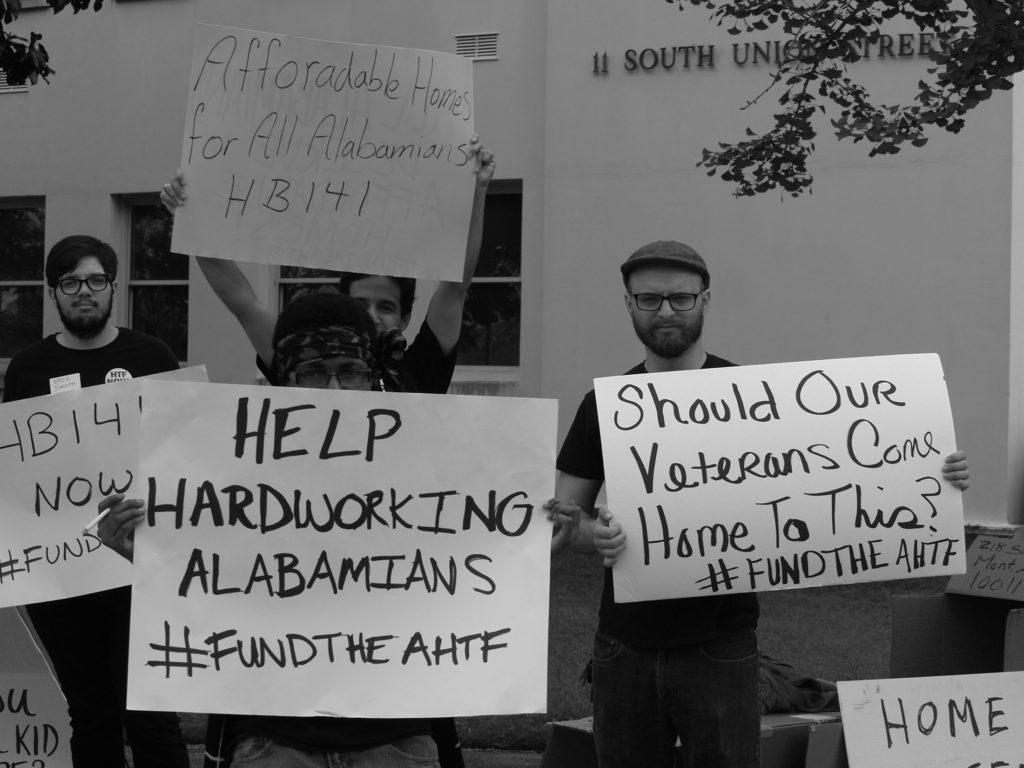
Arise’s Dev Wakeley testified Wednesday before the Legislative Oversight Committee of the Alabama Housing Finance Authority (AHFA). He discussed Arise’s concerns about the slow distribution of federal rental assistance authorized under the American Rescue Plan Act. He also shared recommendations to speed up disbursement and increase participation. Here’s the full text of Wakeley’s prepared remarks:
Thank you. My name is Dev Wakeley. I’m here on behalf of the 158 member organizations and nearly 2,000 individual members of Alabama Arise. We are united in our goal of advancing public policies that improve the lives of Alabamians who are marginalized by poverty.
Few policies meet that standard better than emergency rental assistance during a public health crisis. But Alabama’s distribution of federal aid money to prevent eviction during the pandemic has fallen far short of the Emergency Rental Assistance (ERA) program’s goals. This failure has caused long delays in getting aid to thousands of qualified people who need it.
Our first request is for the AHFA to increase transparency in the process of reviewing applications and assisting people in completing them. Specifically, we would like to see public posting of state and local contracts and agreements with companies and entities engaged in the application process, especially the contract and payment details regarding Horne LLP. Arise believes full transparency regarding these vital operations will help increase confidence in the process. That will increase participation and could allow the state to access additional funding upon timely use of existing funds. Horne’s slow pace of progress in ensuring application processing and payment is a matter of public concern.
Faster distribution needed
An increase in obligated money is a step toward using this money the right way. But obligating funds for program use doesn’t keep people housed. Thousands of people who qualify for assistance face eviction. To stop those evictions, relief money must actually reach all qualified renters. Only about $66 million of the $263 million ERA funds will go to renters who have already been paid or are pending payment, just a 25% rate. The only measure that ensures the right policy outcome is actual use of these funds to stave off eviction. This is especially important because an eviction is not just an inconvenience or temporary hardship. Evictions ruin families financially. And the data is clear: Evictions kill, especially during this pandemic.
According to the most recent monthly report, as of Aug. 31 ‒ five days after the CDC eviction moratorium expired ‒ Horne had distributed just 7% of the rental assistance available through this program. Yet that private company has already reaped $6.2 million, or 67% of its maximum permissible fees under the contract. At this rate, Horne will max out their contractually permissible payment five full years before distribution of the remaining assistance funds. The money paid to Horne is more than a third of the entire ERA amount distributed through Aug. 31. Real disbursement rates must increase dramatically and immediately to justify this level of expenditure on a contractor.
The pace of approval and disbursement statewide has improved over the past month. But Arise has spoken with landlord representatives who report the initial and ongoing difficulties have left some companies reluctant to engage in the ERA process at all. To convince more landlords to participate, Arise has specific requests to help separate the current program from the difficulties associated with standing up an assistance program from scratch.
Recommended improvements
We ask the AHFA to reach out to local jurisdictions and encourage the broadest possible reading of eligibility standards and application criteria at all local agencies. Some localities have been slow in following updated federal guidance, resulting in a wide disparity of distribution rates across agencies. The federal government is aware these funds are being sought and used by people who genuinely need them, and there is no reasonable possibility of clawback of disbursed funds.
Next, we ask the AHFA to “rebrand” the program and reach out to landlord groups and the public to indicate a break with earlier inconsistent practices. A commitment to faster processing and disbursement alongside more flexible documentation requirements could build confidence in a program that requires active public engagement.
Emergency rental assistance is a clear example of a program that benefits all involved. Landlords and tenants both benefit. And the state will benefit greatly from smoothing out the existing process, both through that money making its way into the broader economy and through fewer expenses associated with evictions and housing insecurity.
Standing up these programs has involved a steep learning curve, but the AHFA has an opportunity to make improvements now. Alabama Arise asks the AHFA to seize this opportunity to make process efficiency improvements that could keep thousands of vulnerable Alabamians housed as winter approaches while a dangerous virus continues to spread in the community. Thank you for your time and willingness to hear our perspective.

